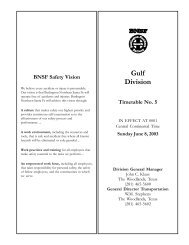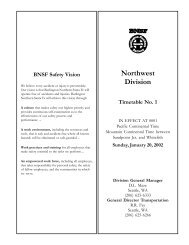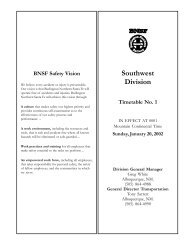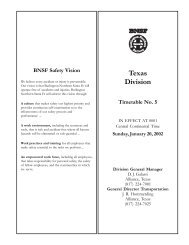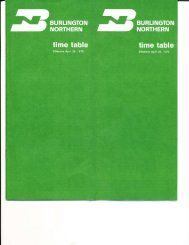2 11/5/03 - Friends of the Burlington Northern Railroad
2 11/5/03 - Friends of the Burlington Northern Railroad
2 11/5/03 - Friends of the Burlington Northern Railroad
Create successful ePaper yourself
Turn your PDF publications into a flip-book with our unique Google optimized e-Paper software.
58 NORTHWEST DIVISION—No. 2—November 5, 20<strong>03</strong>—Scenic Subdivision<br />
Min<br />
Chart B<br />
1200<br />
FEET<br />
2400 FEET<br />
Sec<br />
MPH<br />
Min<br />
Sec<br />
MPH<br />
27<br />
30<br />
55<br />
30<br />
28<br />
29<br />
57<br />
29<br />
29<br />
28<br />
59<br />
28<br />
30<br />
27<br />
1 00<br />
27<br />
32<br />
26<br />
1 <strong>03</strong><br />
26<br />
33<br />
25<br />
1 05<br />
25<br />
34<br />
24<br />
1 08<br />
24<br />
36<br />
23<br />
1 <strong>11</strong><br />
23<br />
38<br />
22<br />
1 15<br />
22<br />
39<br />
21<br />
1 18<br />
21<br />
41<br />
20<br />
1 22<br />
20<br />
43<br />
19<br />
1 26<br />
19<br />
46<br />
18<br />
1 31<br />
18<br />
48<br />
17<br />
1 37<br />
17<br />
51<br />
16<br />
1 42<br />
16<br />
55<br />
15<br />
1 49<br />
15<br />
59<br />
14<br />
1 57<br />
14<br />
1 <strong>03</strong><br />
13<br />
2 06<br />
13<br />
1 09<br />
12<br />
2 17<br />
12<br />
1 15<br />
<strong>11</strong><br />
2 29<br />
<strong>11</strong><br />
1 22<br />
10<br />
2 44<br />
10<br />
1 31<br />
9 3 02<br />
9<br />
1 43<br />
8 3 25<br />
8<br />
1 57<br />
7 3 54<br />
7<br />
2 17<br />
6 4 33<br />
6<br />
2 44<br />
5 5 28<br />
5<br />
L. CASCADE TUNNEL EMERGENCY ACTION PLAN<br />
(See Chart C)<br />
1. Consider hazardous material involvement in each<br />
situation before any action taken.<br />
2. Consider operation <strong>of</strong> fans and direction <strong>of</strong><br />
movement.<br />
3. If a train incident occurs requiring crew members to<br />
leave <strong>the</strong> locomotive cab to inspect <strong>the</strong>ir train, crew<br />
members must put on SCBA unit before investigating<br />
<strong>the</strong> problem(s). Hood must be worn with air<br />
activated if a crew member experiences breathing<br />
discomfort.<br />
4. If an emergency condition exists, such as a release<br />
<strong>of</strong> hazardous material, use <strong>of</strong> Survivair SCBA is<br />
required.<br />
5. If distance or situation warrants, walk out if<br />
necessary. Replacement air cylinders are located in<br />
each bay.<br />
Cascade Tunnel Communications—BNSF network<br />
telephones are located in each bay <strong>of</strong> <strong>the</strong> tunnel in protective<br />
boxes. When dialing a company number, you must dial 8+ (<strong>the</strong><br />
number). A speed dial for <strong>the</strong> Seattle East Dispatcher is 616.<br />
Event<br />
I. Undesired<br />
Emergency Air<br />
Brake Application,<br />
Break-in-two or<br />
Derailment<br />
Action<br />
Chart C<br />
If any hazardous material is within tunnel, use<br />
breathing equipment immediately. After PCS<br />
(power cut<strong>of</strong>f switch) has reset on <strong>the</strong> lead<br />
locomotive, if air does not begin to restore within<br />
two minutes, observe <strong>the</strong> following:<br />
1. If <strong>the</strong>re is reasonable suspicion that a<br />
derailment has occurred, cut <strong>of</strong>f locomotives if<br />
possible, if not, walk-exit <strong>the</strong> tunnel. Obtain<br />
supplemental breathing equipment as needed.<br />
2. Use breathing equipment, evaluate, secure,<br />
and/or repair if possible. Obtain supplemental<br />
breathing equipment as needed.<br />
I I. Fire (Obvious) Eastward :<br />
1. Cut <strong>of</strong>f power,<br />
exit tunnel.<br />
2. Determine<br />
train, if any.<br />
3. Shut <strong>of</strong>f fans, after exit.<br />
4. Close doors.<br />
5. Do not return to tunnel.<br />
Westward:<br />
1. Order fans<br />
open door.<br />
2. Cut <strong>of</strong>f power,<br />
train, exit tunnel.<br />
3. Determine hazardous<br />
4. Close door after exit.<br />
5. Do not return.<br />
III. Engine(s)<br />
derailed<br />
Helper engines in<br />
train<br />
T rain with caboose Eastward :<br />
Order fans shut<br />
Westward:<br />
Order fans remain<br />
leave train angle cock open -<br />
location <strong>of</strong> hazardous material in<br />
shut <strong>of</strong>f by dispatcher phone, and<br />
leaving angle cock open on<br />
material in train, if any.<br />
1. Advise dispatcher - control fans to provide<br />
maximum fresh air.<br />
2. Shut down and secure all locomotive units.<br />
3. Exit tunnel using power if possible with<br />
dispatcher authority.<br />
1. Advise dispatcher.<br />
2. Exit tunnel ei<strong>the</strong>r with <strong>the</strong> head end or back<br />
out with rear <strong>of</strong> train leaving angle cock open on<br />
portion <strong>of</strong> train left standing.<br />
<strong>of</strong>f and exit if possible.<br />
on and exit if possible.<br />
In an emergency situation, dialing 9-9<strong>11</strong> will connect<br />
Wenatchee Emergency Operations, identical standard 9<strong>11</strong><br />
calls.<br />
ETD and HTD Failures<br />
When an enroute failure occurs at anytime controlling<br />
locomotive is within or will be within <strong>the</strong> Cascade Tunnel, MP<br />
1700.34 to MP 1708.17, train may proceed at maximum<br />
authorized speed as long as train is under control until entire<br />
train exits <strong>the</strong> Cascade Tunnel.<br />
If communications between HTD/EOT is lost enroute, <strong>the</strong> train<br />
must not pass Merritt (westbound) or Skykomish (eastbound)<br />
until communication is reestablished. A supply <strong>of</strong> replacement<br />
batteries and EOT’s will be available at Merritt (Tool House)<br />
and Skykomish (Depot). Notify dispatcher if battery or EOT is<br />
removed for use as well as Mechanical Help Desk with failure<br />
information.<br />
Minimum Dynamic Brake Requirements<br />
Before descending grades described in <strong>the</strong> chart, it must be<br />
known that locomotive consist(s) has <strong>the</strong> minimum number <strong>of</strong><br />
operative axles <strong>of</strong> dynamic brake. If train does not meet <strong>the</strong><br />
minimum requirements as outlined, train must not proceed. For<br />
<strong>the</strong> purpose <strong>of</strong> this rule, <strong>the</strong> weight <strong>of</strong> locomotives with<br />
inoperative dynamic brakes is to be included in train’s total<br />
trailing tonnage.




